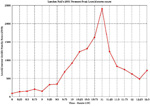





|
|
|
What is calc? |
||
| [chongo's home] [Astronomy] [Mathematics] [Prime Numbers] [Programming] [Technology] [contacting Landon] | ||
Calc is an interactive calculator which provides for easy large numeric calculations, but which also can be easily programmed for difficult or long calculations. It can accept a command line argument, in which case it executes that single command and exits. Otherwise, it enters interactive mode. In this mode, it accepts commands one at a time, processes them, and displays the answers. In the simplest case, commands are simply expressions which are evaluated. For example, the following line can be input:and the calculator will print:3 * (4 + 1)Calc as the usual collection of arithmetic operators +, -, /, * as well as ^ (exponentiation), % (modulus) and // (integer divide). For example:15will produce:3 * 19^43 - 1Notice that calc values can be very large. For example:29075426613099201338473141505176993450849249622191102976will print:2^23209-1The special '.' symbol (called dot), represents the result of the last command expression, if any. This is of great use when a series of partial results are calculated, or when the output mode is changed and the last result needs to be redisplayed. For example, the above result can be modified by typing:402874115778988778181873329071 ... many digits ... 3779264511and the calculator will print:. % (2^127-1)For more complex calculations, variables can be used to save the intermediate results. For example, the result of adding 7 to the previous result can be saved by typing:39614081257132168796771975167Functions can be used in expressions. There are a great number of pre-defined functions. For example, the following will calculate the factorial of the value of 'old':curds = 15 whey = 7 + 2*curdsand the calculator prints:fact(whey)The calculator also knows about complex numbers, so that typing:13763753091226345046315979581580902400000000will print:(2+3i) * (4-3i) cos(.)The calculator can calculate transcendental functions, and accept and display numbers in real or exponential format. For example, typing:17+6i -55.50474777265624667147+193.9265235748927986537iprints:config("display", 70) epsilon(1e-70) sin(1)Calc can output values in terms of fractions, octal or hexadecimal. For example:0.8414709848078965066525023216302989996225630607983710656727517099919104will print:config("mode", "fraction"), (17/19)^23 base(16), (19/17)^29All numbers are represented as fractions with arbitrarily large numerators and denominators which are always reduced to lowest terms. Real or exponential format numbers can be input and are converted to the equivalent fraction. Hex, binary, or octal numbers can be input by using numbers with leading '0x', '0b' or '0' characters. Complex numbers can be input using a trailing 'i', as in '2+3i'. Strings and characters are input by using single or double quotes. Commands are statements in a C-like language, where each input line is treated as the body of a procedure. Thus the command line can contain variable declarations, expressions, labels, conditional tests, and loops. Assignments to any variable name will automatically define that name as a global variable. The other important thing to know is that all non-assignment expressions which are evaluated are automatically printed. Thus, you can evaluate an expression's value by simply typing it in. Many useful built-in mathematical functions are available. Use the:19967568900859523802559065713/257829627945307727248226067259 0x9201e65bdbb801eaf403f657efcf863/0x5cd2e2a01291ffd73bee6aa7dcf7d1command to list them. You can also define your own functions by using the 'define' keyword, followed by a function declaration very similar to C.help builtinThus the input:define f2(n) { local ans; ans = 1; while (n > 1) ans *= (n -= 2); return ans; }will produce;f2(79)Functions which only need to return a simple expression can be defined using an equals sign, as in the example:1009847364737869270905302433221592504062302663202724609375Thus the input:define sc(a,b) = a^3 + b^3will produce;sc(31, 61)Variables in functions can be defined as either 'global', 'local', or 'static'. Global variables are common to all functions and the command line, whereas local variables are unique to each function level, and are destroyed when the function returns. Static variables are scoped within single input files, or within functions, and are never destroyed. Variables are not typed at definition time, but dynamically change as they are used. For more information about the calc language and features, try:256772In particular, check out the other help functions listed in the overview help file.help overview
|
© 1994-2013
Landon Curt Noll chongo (was here) /\oo/\ $Revision: 8.1 $ $Date: 2022/07/07 22:55:49 $ |